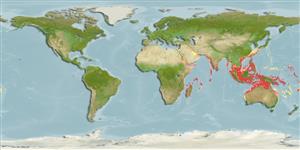Common names from other countries
Environment: milieu / climate zone / depth range / distribution range
Ökologie
seewasser demersal; tiefenbereich 18 - 92 m (Ref. 11441). Tropical
Indo-West Pacific: Persian Gulf through the eastern Indian Ocean to the East Indies.
Size / Gewicht / Alter
Maturity: Lm ? range ? - ? cm
Max length : 14.0 cm TL Männchen/unbestimmt; (Ref. 9797)
Rückenflossenstacheln (insgesamt) : 0; Rückenflossenweichstrahlen (insgesamt) : 65 - 77; Afterflossenstacheln: 0; Afterflossenweichstrahlen: 41 - 50. Ground color yellowish or yellowish brown; dorsal, anal and caudal fins paler than body with dark spots. Blind side whitish. Some anterior dorsal fin rays elongated in males, not in females, all rays except a few at posterior end of fin unbranched. Pectoral fin on eyed side with 11-13 rays, on blind side with 10-13 rays. Caudal fin with 13-14 branched rays and rounded margin.
Inhabits sand and mud bottoms (Ref. 9797). Frequently collected in areas near river mouths (Ref. 9797). Feeds on bottom-living animals (Ref. 9797). Mostly used in making fish meal but is also marketed fresh (Ref. 9797).
Life cycle and mating behavior
Maturities | Fortpflanzung | Spawnings | Egg(s) | Fecundities | Larven
Kuronuma, K. and Y. Abe, 1986. Fishes of the Arabian Gulf. Kuwait Institute for Scientific Research, State of Kuwait, 356 p. (Ref. 5999)
IUCN Rote Liste Status (Ref. 130435)
CITES (Ref. 128078)
Not Evaluated
Bedrohung für Menschen
Harmless
Nutzung durch Menschen
Fischereien: weniger kommerziell
Tools
Zusatzinformationen
Download XML
Internet Quellen
Estimates based on models
Preferred temperature (Ref.
115969): 23.7 - 28.6, mean 27.5 (based on 661 cells).
Phylogenetic diversity index (Ref.
82804): PD
50 = 1.0156 [Uniqueness, from 0.5 = low to 2.0 = high].
Bayesian length-weight: a=0.01122 (0.00514 - 0.02450), b=3.04 (2.87 - 3.21), in cm Total Length, based on all LWR estimates for this body shape (Ref.
93245).
Trophic level (Ref.
69278): 3.5 ±0.37 se; based on food items.
Widerstandsfähigkeit (Ref.
120179): hoch, Verdopplung der Population dauert weniger als 15 Monate. (Preliminary K or Fecundity.).
Fishing Vulnerability (Ref.
59153): Low vulnerability (10 of 100).
